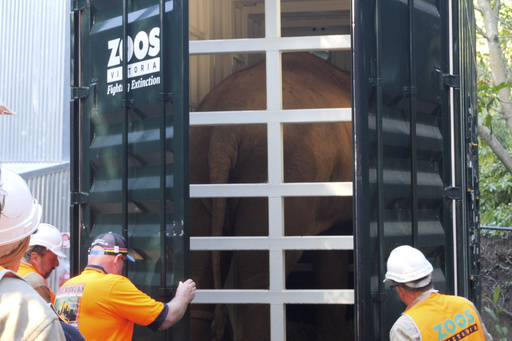
MELBOURNE, Australia — Upon their reunion after a meticulous five-day relocation, elephants excitedly trumpeted, touched trunks, and flapped their large ears. The nine Asian elephants were moved 40 kilometers (25 miles) from Melbourne Zoo to a significantly larger habitat at Werribee Open Range Zoo, a transition announced on Thursday by Zoos Victoria. Their journey was facilitated by police escorts and synchronized traffic signals, ensuring a smooth transport across three truck convoys.
The response from the elephants suggested they were pleased with the change, according to the elephants’ manager, Erin Gardiner. “We observed behaviors indicating that they felt comfortable and were excited to reunite, characterized by extensive ear flapping, trunk interactions, and various vocalizations,” Gardiner shared. She added, “We heard lots of roaring, trumpeting, and squeaks, demonstrating their happiness in seeing each other. By the afternoon, the calves were engaging in play, and the way they traveled was quite impressive.”
The meticulous planning for this move initiated nearly two years prior, incorporating training sessions for the elephants to adeptly enter and exit their transport crates. Veterinarian Bonnie McMeekin emphasized the importance of this preparation, stating, “The training provided comfort; otherwise, ensuring a safe transport would have been incredibly difficult.”
With a total weight of 23 metric tons (25 U.S. tons), the elephants were given mild sedatives to alleviate stress during their 40-minute journeys. To maintain balance, the adult elephants were also tethered at their ankles. During transportation, the trucks predominantly maintained a speed of around 60 kph (37 mph), taking careful turns as needed. Specialized air-conditioned crates were crafted for the journey, with three designed specifically for mothers traveling with their calves.
The group comprises one adult male, five adult females, and three calves, all aged two years. The solitary adult male began his journey separately on February 6, being lifted onto a truck by a crane in a dedicated crate. Subsequently, an aunt traveled in one truck while a crate containing a mother and her calf was transported separately. Two mothers with their calves, along with the herd matriarch, arrived in three crates on Monday, leading to the reunion of the entire group. According to McMeekin, two days apart is a substantial duration for females in a herd to be separated.
On Wednesday, the elephants were introduced to their expansive new enclosure, spanning 21 hectares (52 acres), which features two swimming pools that are approximately 3.5 meters (11 feet) deep. This new habitat is ten times larger than their previous home at Melbourne Zoo, where they had outgrown a 2-hectare (5-acre) area. Their new environment, valued at around 88 million Australian dollars ($55 million), includes mud wallows, specialized barns for elephants, and a communal sleeping space with 3,300 metric tons (3,600 U.S. tons) of sand.
The elephants will have a few weeks to acclimate to their new surroundings before the habitat is made accessible to the public.

